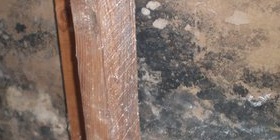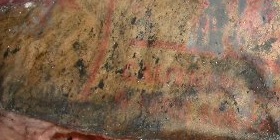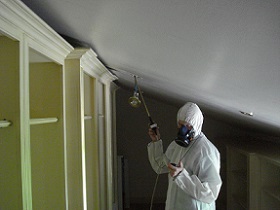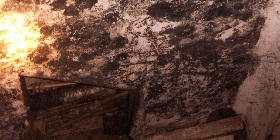Mould in wall cavity

One the most dangerous mould contamination scenarios are mould contamination within wall cavities. The simple reason for the seriousness of this issue is that the mould is not immediately visible to the naked eye and has therefore time to spread across very large areas of the affected building. Occupants usually became aware that something is wrong by noticing increase in adverse health symptoms when entering certain parts of the house.
Mould in wall cavity can sometimes occur due to water condensation when outdoor air comes in contact with the cavity side of the cooled interior surface. It is a particular problem when rooms are decorated with impermeable wall covering such as vinyl wallpaper. These impervious wall coverings trap moisture between the finish and the gypsum board. The moisture from the outdoor air naturally passes through the exterior building envelope and may condense on the cool wallpaper adhesive. For this reason vapour barriers should be on the warm side of a wall and should not trap moisture in the wall.Another reason for mould in wall cavity is a service leak. Service leaks such as dripping pipes may not always become immediate obvious. Slow leak are particularly damaging because they significantly increase the humidity in the wall cavity without causing immediately visible damage on the outside.
Moulds usually do not get established on wooden surfaces after brief exposure to water. All woods contain naturally present chemical preventing fungal attack. If however the humid conditions persist for longer periods of time than mould contamination is inevitable.
If mould has become established in a wall cavity, it will not continue to grow if the cavity is dry. Thorough drying of the wall cavity will stop the mould from spreading. The extent of contamination will not decrease but it will not increase either. Moulds reproduce by production of a large number of spores. Fungal spores are designed to withstand long periods of time (decades for some species) in stasis and are also resistant to drying. If the mould in wall cavity is of toxic type the toxins contains in the fungal hyphae and spores will remain stable for very long periods of time.
The effect of thermal insulation on mould in wall cavity

Commonly used thermal insulation in wall cavities increases interior wall surface temperatures thus reducing the likelihood of interior surface mould, mildew and condensation. The side effect of the use of thermal insulation is that it also reduces the heat loss from indoor areas into the wall cavities. This leads to a decrease of the temperature in the wall cavities which increases the likelihood of concealed condensation.
Water vapour firstly condenses on the “back side” of plywood or fibber board panelling. As the insulation value is increased in the wall cavities, so does the potential for hidden condensation. Concealed condensation can be controlled by either or both of the following strategies:
- Reducing the entry of moisture into the wall cavities
- Elevating the temperature of the first condensing surface.
Inspecting wall cavity for mould

If inspection of the wall cavities for the presence of mould is required this need to be done with care. The gradual approach to opening up the walls is strongly recommended. Small section of the wall should be open and is mould is observed the section can be easily put back and sealed.
Indoor air quality professional evaluate the presence of mould in wall cavities by taking a sample of air from within the wall cavity. The samples can be either evaluated for the presence of fungal spores or for the presence of volatile chemicals produced by the moulds. Boroscopic inspections of wall cavities through a small hole are also very common.
Removing mould in wall cavity

Once the mould contamination of the wall cavity has been confirmed and is extensive several approaches are available. The preferred option is always to remove the water damaged panelling, expose the mould and thorough clean the wall cavity area. Removal of mould from wall cavity is always carried dour under control conditions with HEPA filtration. To establish controlled conditions for mould clean up a construction of air tight enclosure is required. During removal operation the mould is removed from the wall cavity which is then sterilised, mycotoxins are neutralised (specific chemicals are used for mycotoxins neutralisation) and the cavity is dried.
If opening of the cavity is not practicable for whatever reason fumigation, gas ozone sterilisation and sealing of mould can be used. This approach does not actually removes the mould from the cavity and the potential for contamination of indoor areas remains.
